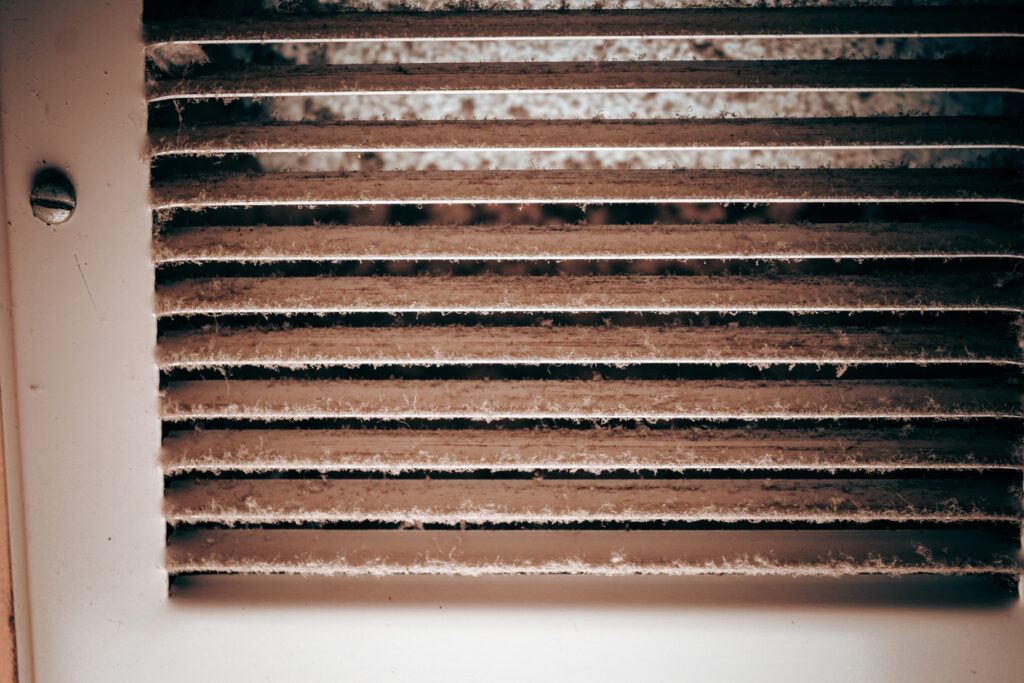1. Formaldehyde in Furniture and Flooring

That “new” smell from furniture or flooring could be formaldehyde. This colorless gas is often used in glues and adhesives to make pressed wood products. It’s a known human carcinogen and can also cause eye irritation, sore throats, and worsen asthma symptoms. Since formaldehyde is a volatile organic compound, it releases gas into your home air over time without any obvious warning.
The risk is higher in warmer seasons and homes with poor ventilation. Furniture and laminate flooring are common sources, especially budget-friendly options. To reduce exposure, look for items labeled “low emitting” or GREENGUARD certified. Increasing indoor airflow and using indoor plants like spider plants or ferns can also help clear the air. According to the EPA, long-term exposure can lead to serious health effects if not addressed.
2. Phthalates in Air Fresheners
Air fresheners make our homes smell fresh, but many are loaded with phthalates. These synthetic chemicals help scents last longer but can disrupt hormones and impact fertility. They’re especially risky for children and pets, who are more sensitive to chemical exposure. The tricky part? Phthalates are usually hidden under vague terms like “fragrance” or “parfum” on product labels, so you might not even realize you’re using them every day.
You can cut down exposure by choosing natural alternatives like essential oil diffusers or baking soda. Improve ventilation by opening windows regularly and avoid using spray or plug-in air fresheners altogether. According to the CDC, phthalates are detected in the majority of Americans and are linked to reproductive and respiratory concerns. A cleaner, less fragranced space might just be healthier than you think.
3. VOCs in Paints and Cleaning Products
Many common household products release volatile organic compounds (VOCs) into the air. These include paints, air fresheners, oven cleaners, and even some laundry detergents. VOCs can cause dizziness, throat irritation, and headaches. Long-term exposure has been linked to liver damage and even cancer. If you get lightheaded after cleaning or painting, you’ve likely been exposed to VOCs without even knowing it.
Switching to low-VOC or VOC-free products is one of the best moves you can make. Open your windows when cleaning or painting to increase ventilation. Natural cleaning products like vinegar and baking soda are effective and much safer. According to NIH, VOC levels are consistently higher indoors than outdoors, making indoor air quality a top concern for long-term health.
4. Flame Retardants in Couches and Electronics
Flame retardants sound protective, but many are harmful to your health. These chemicals are added to furniture cushions, mattresses, and electronics to slow the spread of fire. But over time, they break down into tiny particles and settle into household dust. Constant exposure, especially for children who play on the floor, has been linked to hormone disruption and developmental delays.
Many manufacturers still use them despite health concerns. To limit exposure, choose furniture labeled as free from flame retardants. Vacuuming with a HEPA filter and dusting with a damp cloth can help reduce the toxins accumulating in your home. According to the NIH, flame retardants accumulate in the human body over time and have no known health benefits when used in furniture.
5. BPA in Plastic Containers and Cans
BPA is often found in plastic food containers, water bottles, and canned food linings. It’s used to harden plastics and create a protective coating inside cans. The problem is, BPA can leach into food and drinks, especially when containers are heated. This chemical mimics estrogen and may interfere with hormone levels, potentially leading to fertility problems and heart conditions.
To stay safer, use glass or stainless-steel containers, especially for hot food. Don’t microwave plastic or wash it in the dishwasher if it isn’t BPA-free. Even “BPA-free” labels aren’t always trustworthy, since replacements like BPS may be just as harmful. According to the FDA, limiting BPA exposure can help reduce long-term health risks.
6. Ammonia in Glass and Surface Cleaners
Ammonia is a powerful cleaner found in many glass and surface products. It’s great for cutting through grease and leaving a streak-free shine, but it’s also an irritant that can affect your skin, eyes, and lungs. Inhaling ammonia can trigger asthma symptoms and cause headaches or coughing fits, especially in poorly ventilated areas. People with breathing problems or small children are particularly vulnerable to the effects of ammonia exposure.
Mixing ammonia with bleach, even accidentally, creates a toxic gas called chloramine. This chemical reaction can be extremely dangerous and even life-threatening. To stay safe, read labels carefully and avoid products with ammonia or use them sparingly in well-ventilated areas. Vinegar or castile soap can be safer alternatives that clean effectively. You don’t need harsh chemicals to keep your home sparkling, just smarter choices.
7. Lead in Old Paint and Plumbing
Lead was banned in U.S. house paints in 1978, but many older homes still carry the legacy. Flaking lead-based paint or contaminated dust can be easily inhaled or ingested by children, leading to developmental delays and behavioral issues. Adults can also suffer from high blood pressure, joint pain, and memory problems when exposed to lead over time. The risk is especially high during renovations or repairs.
Old plumbing pipes can also be a hidden source of lead in drinking water. If your home was built before the mid-1980s, it’s worth testing your water. The CDC recommends using certified filters that remove lead and running cold water for a minute before use. Professional lead abatement may be necessary in older homes. Don’t assume your home is safe just because you can’t see the danger.
8. Pesticide Residue on Fresh Produce

Even fruits and vegetables come with toxic hitchhikers. Many are treated with pesticides that leave behind chemical residue long after they hit your grocery cart. These residues can be hard to remove and may build up in your body over time. Chronic exposure has been linked to fertility issues, hormone disruption, and certain types of cancer. Kids and pregnant women are particularly sensitive to these harmful chemicals.
Washing your produce with water helps, but it may not remove all residues. A mixture of baking soda and water is more effective for breaking down pesticides. Buying organic for high-risk produce like strawberries, spinach, and apples is another great step. The Environmental Working Group releases an annual “Dirty Dozen” list to help shoppers identify the most contaminated fruits and veggies. Your salad should help your health, not harm it.
9. Teflon Coating on Nonstick Cookware
Nonstick pans make cooking and cleaning easier, but they may come with risks. Older nonstick cookware is often coated with polytetrafluoroethylene (PTFE), commonly known as Teflon. When overheated, this coating can break down and release fumes that cause flu-like symptoms known as “Teflon flu.” The fumes are especially dangerous to pet birds, who can die from exposure in minutes.
Newer pans labeled as “PFOA-free” are safer, but damage like scratches or flaking can still expose you to questionable materials. Experts recommend using stainless steel, cast iron, or ceramic cookware as safer alternatives. If you do use nonstick pans, avoid high heat and replace them at the first sign of wear. Cooking should be a joy, not a chemical experiment in your kitchen.
10. Mold in Bathrooms and Basements
Mold loves moisture, and bathrooms and basements are its favorite hiding places. While not all mold is toxic, some types release mycotoxins that can trigger allergies, respiratory problems, and fatigue. If you smell a musty odor or notice black spots around tiles or walls, mold could be the culprit. People with asthma or weakened immune systems are especially at risk from prolonged exposure.
To prevent mold, fix any leaks quickly, run exhaust fans after showers, and use a dehumidifier in damp spaces. Clean visible mold with white vinegar or hydrogen peroxide, not bleach, which can worsen the problem in porous materials. Mold is sneaky and persistent, so staying on top of humidity and moisture is your best defense. A fresh-smelling bathroom isn’t just nice, it’s essential.
11. Synthetic Fragrances in Personal Care Products
Your favorite shampoo or lotion may smell amazing, but synthetic fragrances can hide a cocktail of undisclosed chemicals. These artificial scents are protected as trade secrets, meaning manufacturers aren’t required to list their full ingredients. Many contain phthalates or allergens that can disrupt hormones, irritate skin, or even affect reproductive health over time. You may not realize what’s behind that “clean” scent.
Look for products labeled “fragrance-free” or “naturally scented” with essential oils. The fewer ingredients, the better. People with sensitive skin, allergies, or asthma should be especially cautious. Everyday items like deodorant, body wash, and hair products can be culprits. What you put on your body is just as important as what you put in it. Reading the label could save you from long-term issues you never saw coming.
12. Dry Cleaning Chemicals in Clothes
That “just dry-cleaned” smell may come from perchloroethylene (perc), a common solvent used in traditional dry cleaning. Perc is classified as a likely carcinogen and can affect your nervous system, liver, and kidneys with prolonged exposure. It doesn’t fully evaporate either, meaning your clothes can carry it into your home and release it into your air for days after cleaning.
Choose “green” dry cleaners that use wet cleaning or liquid CO₂ methods instead. Air out dry-cleaned clothes outside before bringing them indoors to limit your exposure. Over time, repeated contact with perc-laced fabrics can pose real health risks. Looking good shouldn’t come at the cost of breathing in toxic chemicals. A little caution goes a long way when it comes to your wardrobe.
13. Chlorine in Tap Water
Chlorine is added to public drinking water to kill bacteria, but high levels can be irritating. It may dry out your skin, trigger respiratory issues, and cause that harsh pool-like smell in your shower or sink. Though regulated by the EPA, chlorine exposure through bathing and cooking can still add up, especially in homes without filtration systems.
Installing a carbon-based water filter for drinking and a showerhead filter for bathing can help reduce chlorine exposure. Letting tap water sit uncovered for a few hours before drinking can also allow chlorine to dissipate naturally. If you have dry, itchy skin or sensitive airways, chlorine might be the hidden reason. Your water should refresh you, not stress your system.
14. Dust Buildup in Air Vents and Filters

Dust may seem harmless, but it’s often loaded with pollutants. It can contain everything from pollen and pet dander to flame retardants, VOCs, and heavy metals. When it builds up in air vents, filters, or behind furniture, it gets recirculated into your living space. Breathing it in can worsen allergies, irritate the lungs, and contribute to chronic fatigue or sinus issues.
Change your HVAC filters regularly and vacuum using a HEPA filter. Dust surfaces with a damp cloth to trap particles instead of spreading them around. Don’t forget overlooked spots like fan blades, baseboards, and under furniture. Keeping dust under control helps keep your entire home’s air cleaner. You can’t see every particle, but your body feels the difference when you breathe a little easier.
